Physical association of the WC-1 photoreceptor and the histone acetyltransferase NGF-1 is required for blue light signal transduction in Neurospora crassa
- PMID: 22875992
- PMCID: PMC3459862
- DOI: 10.1091/mbc.E12-02-0142
Physical association of the WC-1 photoreceptor and the histone acetyltransferase NGF-1 is required for blue light signal transduction in Neurospora crassa
Abstract
In Neurospora crassa and other filamentous fungi, light-dependent-specific phenomena are regulated by transcription factors WC-1 and WC-2. In addition to its transcriptional activity, WC-1 is able to directly sense light stimuli through a LOV sensor domain. Its location in the nucleus and heterodimerization with WC-2, together with the presence of a zinc-finger DNA-binding domain and an environmental sensor domain, all resemble the functional evolutionary architecture adopted by vertebrate nuclear receptors (NRs). Here we describe a scenario in which WC-1 represents a functional orthologue of NRs and acts through association with the chromatin-modifying coactivator NGF-1, which encodes a homologue of the yeast Gcn5p acetyltransferase. To support this view, we show a direct association between WC-1 and NGF-1 that depends on a WC-1 region containing a conserved functional LXXLL motif, a signature previously described as being an exclusive feature of NR/coactivator interaction. Our data suggest that a WC-1/NGF-1 complex is preassembled in the dark on light-inducible promoters and that, after exposure to light stimulation, NGF-1-associated HAT activity leads to histone H3 acetylation and transcriptional activation. Finally, we provide evidence for a NGF-1-independent acetylated form of WC-1. Overall our data indicate that Neurospora and higher eukaryotes share a common mechanism for the signal transduction of environmental stimuli.
Figures
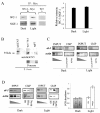
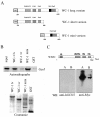
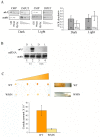
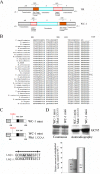
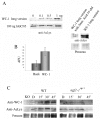

Similar articles
-
The Neurospora crassa White Collar-1 dependent blue light response requires acetylation of histone H3 lysine 14 by NGF-1.Mol Biol Cell. 2006 Oct;17(10):4576-83. doi: 10.1091/mbc.e06-03-0232. Epub 2006 Aug 16. Mol Biol Cell. 2006. PMID: 16914525 Free PMC article.
-
White collar-1, a DNA binding transcription factor and a light sensor.Science. 2002 Aug 2;297(5582):840-3. doi: 10.1126/science.1072795. Epub 2002 Jul 4. Science. 2002. PMID: 12098705
-
Alternative Use of DNA Binding Domains by the Neurospora White Collar Complex Dictates Circadian Regulation and Light Responses.Mol Cell Biol. 2015 Dec 28;36(5):781-93. doi: 10.1128/MCB.00841-15. Mol Cell Biol. 2015. PMID: 26711258 Free PMC article.
-
White collar proteins: PASsing the light signal in Neurospora crassa.Trends Microbiol. 1997 Nov;5(11):458-62. doi: 10.1016/S0966-842X(97)01144-X. Trends Microbiol. 1997. PMID: 9402704 Review.
-
Seeing the light: news in Neurospora blue light signal transduction.Adv Genet. 1999;41:35-54. doi: 10.1016/s0065-2660(08)60150-9. Adv Genet. 1999. PMID: 10494616 Review. No abstract available.
Cited by
-
The transcription factor PRO44 and the histone chaperone ASF1 regulate distinct aspects of multicellular development in the filamentous fungus Sordaria macrospora.BMC Genet. 2018 Dec 13;19(1):112. doi: 10.1186/s12863-018-0702-z. BMC Genet. 2018. PMID: 30545291 Free PMC article.
-
PER2 mediates CREB-dependent light induction of the clock gene Per1.Sci Rep. 2021 Nov 5;11(1):21766. doi: 10.1038/s41598-021-01178-6. Sci Rep. 2021. PMID: 34741086 Free PMC article.
-
Histone Deacetylase HDA-2 Regulates Trichoderma atroviride Growth, Conidiation, Blue Light Perception, and Oxidative Stress Responses.Appl Environ Microbiol. 2017 Jan 17;83(3):e02922-16. doi: 10.1128/AEM.02922-16. Print 2017 Feb 1. Appl Environ Microbiol. 2017. PMID: 27864177 Free PMC article.
-
A crucial role for dynamic expression of components encoding the negative arm of the circadian clock.Nat Commun. 2023 Jun 8;14(1):3371. doi: 10.1038/s41467-023-38817-7. Nat Commun. 2023. PMID: 37291101 Free PMC article.
-
Epigenetic and Posttranslational Modifications in Light Signal Transduction and the Circadian Clock in Neurospora crassa.Int J Mol Sci. 2015 Jul 7;16(7):15347-83. doi: 10.3390/ijms160715347. Int J Mol Sci. 2015. PMID: 26198228 Free PMC article. Review.
References
-
- Baima S, Macino G, Morelli G. Photoregulation of the albino-3 gene in Neurospora crassa. J Photochem Photobiol. 1991;11:107–115. - PubMed
-
- Bain DL, Heneghan AF, Connaghan-Jones KD, Miura MT. Nuclear receptor structure: implications for function. Annu Rev Physiol. 2007;69:201–220. - PubMed
-
- Ballario P, Talora C, Galli D, Linden H, Macino G. Roles in dimerization and blue light photoresponse of the PAS and LOV domains of Neurospora crassa white collar proteins. Mol Microbiol. 1998;29:719–729. - PubMed
MeSH terms
Substances
LinkOut - more resources
Full Text Sources
Molecular Biology Databases

